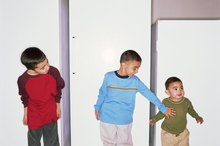Playing Activities for Infants 12-24 Months Old
The primary mode of play for infants and toddlers, age 12 to 24 months, focuses on exploring their world through tactile, visual, sound and movement experiences. Play encourages children in this age group to learn and develop as they attempt, practice and master skills 1. When a toddler discovers she can do something all by herself, she feels successful and confident in her own abilities and is more likely to try new things. Playtime with your child is essential, as it supports her development and deepens the parent-child bond. Through play, young children learn to communicate, form relationships and discover their imagination, sense of humor and creativity 1. (ref. 2)
In, Out, Up and Down
One-year-olds enjoy filling containers of all shapes and sizes over and over again. Cut a whole in a cardboard oatmeal container or large plastic yogurt container and gather safe objects from around the house, such as clothespins, wooden sewing spools and jar lids. Give your child the container and objects, and let her figure out how to drop objects into container and get them out. Play together with blocks and shape-sorting toys; talk about shapes and colors.
- One-year-olds enjoy filling containers of all shapes and sizes over and over again.
- Give your child the container and objects, and let her figure out how to drop objects into container and get them out.
Boxes
How to Stop a Special Needs Child From Playing With Spit in Her Hand
Learn More
Cardboard boxes of various sizes are favorite playthings for 12- to 24-month-old babies to crawl around and put things in. Ask an appliance store for a large empty water heater or refrigerator box that you can make into a playhouse with a door and windows that open. Your toddler can decorate by coloring with fat crayons or pasting colored paper or magazine pictures onto it.
Water
Water play delights most babies and toddlers 1. If it is warm and you have some outdoor space, fill a tub or kiddie pool with water and let your toddler play using small plastic containers, measuring cups, strainers and clean sponges. Filling and emptying is a play activity that occupies a child for a long time 1. Always supervise your baby when she plays with water.
Active Indoor Play
Activities for Adults With Severe Developmental Disabilities
Learn More
Interacting with your toddler is invaluable. She will especially enjoy floor time with you. Rolling a ball back and forth, putting some cushions on the floor to crawl over or jump on, pushing around toy vehicles or playing peek-a-boo from behind furniture are fun activities you and your child can share. Most children enjoy movement, so turn on some music and dance together 1.
- Interacting with your toddler is invaluable.
- Rolling a ball back and forth, putting some cushions on the floor to crawl over or jump on, pushing around toy vehicles or playing peek-a-boo from behind furniture are fun activities you and your child can share.
Outdoor Activities
Many towns have playgrounds designed especially for babies and toddlers. Most 12- to 24 month-olds are not ready to play together, but your child may want you to watch her play with sand toys, a pail and a shovel in the sandbox. She may be ready to try a short slide or be pushed on a swing. If your child enjoys walking, embark on little adventures together, playing “Can You See What I See,” as you identify colors, animals and flowers.
- Many towns have playgrounds designed especially for babies and toddlers.
- Most 12- to 24 month-olds are not ready to play together, but your child may want you to watch her play with sand toys, a pail and a shovel in the sandbox.
Pretending
Children between 1 and 2 years old are discovering their imaginations and beginning to experiment with pretending and dramatic play 1. They imitate adults and have fun working with tools at a toy tool bench or preparing pretend food in a toy kitchen. A favorite toy is the telephone, and 1- to 2-year-olds are excited to call you or run to answer your phone call and talk with you. Toddlers, age 18 to 24 months, enjoy creative play activities, especially dressing up 3. Fill a box with simple costumes, hats, scarves, gloves, ties and shoes, and let your child pretend to be whoever or whatever she wants to be.
Related Articles
References
Writer Bio
Maura Wolf's published online articles focus on women, children, parenting, non-traditional families, companion animals and mental health. A licensed psychotherapist since 2000, Wolf counsels individuals struggling with depression, anxiety, body image, parenting, aging and LGBTQ issues. Wolf has two Master of Arts degrees: in English, from San Francisco State University and in clinical psychology, from New College.









